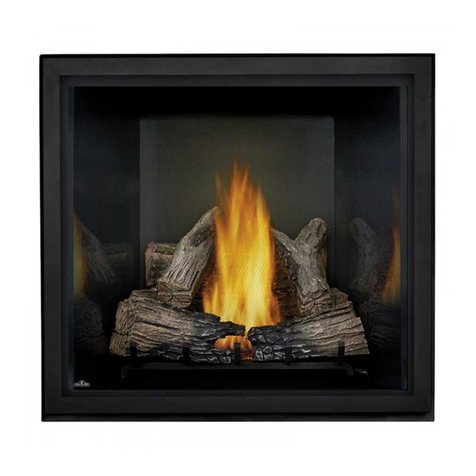
CFDV Series Gas Fireplace
220306739
CONTENTS
Important Safety Information ................................................3
Code Approval........................................................................ 4
Product Features.................................................................... 5
Product Specifications....................................................... 6
Fireplace Controls............................................................. 6
Gas Specifications & Orifice Sizes.................................... 6
Gas Pressures................................................................... 6
High Elevations ................................................................. 6
Cold Climate Insulation .....................................................6
Fireplace & Framing Dimensions...................................... 7
Pre-Installation Information................................................... 6
Before You Start................................................................ 6
Items Required for Installation........................................... 6
Fireplace Framing ............................................................ 6
Fireplace Location............................................................. 8
Clearances .............................................................................. 8
Clearances to Combustibles ............................................. 8
Mantel Clearances ............................................................ 8
Fireplace Installation.............................................................. 9
Secure Fireplace to Floor or Framing................................ 9
Finishing Material.............................................................. 9
Venting Installation Information.......................................... 10
Optional Top Vent Application.......................................... 10
Installation Precautions................................................... 12
General Venting .............................................................. 12
Termination Location................................................ 13
Termination Clearances ........................................... 14
Assembling Vent Pipe ..................................................... 14
Flex Vent Pipe.................................................................14
Twist Lock Pipe ............................................................... 15
Rear Vent Installation Only.............................................. 15
How to Use the Vent Graph............................................. 16
Vent Pipe Clearances...................................................... 17
Rear Wall Vent Applications ........................................... 18
Rear Wall Vent Installation—Twist Lock Pipe.................. 18
Rear Wall Vent Installation—Flex Vent Pipe ...................18
Top Vent Side WallApplication........................................ 19
Vertical Side WallApplications........................................ 21
Vertical Side Wall Installaion—Twist Lock Pipe............... 21
Vertical Side Wall Installation—Flex Vent Pipe ............... 22
Below Grade Installation ................................................. 23
Vertical Through-the-Roof Application............................. 24
Vertical Through-the-Roof Installation............................. 25
Gas Pipe Installation............................................................ 27
Check Gas Type.............................................................. 27
Installation Items Needed................................................ 27
Gas Pipe Installation ....................................................... 28
Check Gas Pressure – Millivolt ....................................... 29
Electrical Installation – Millivolt.......................................... 29
Electrical Wiring............................................................... 29
Remote Wall Mounted Switch......................................... 30
Remote Wall Switch........................................................ 30
Optional DC Remote Systems ........................................ 30
Optional Fan/Blower System BLOT ................................ 31
Optional Fan/Blower System FK12................................. 31
Operating Instructions – Millivolt........................................ 32
For Your Safety Read Before Lighting.............................32
What To Do If You Smell Gas.......................................... 32
Lighting Pilot for the First Time........................................ 32
Lighting Pilot.................................................................... 33
Lighting Burner................................................................ 34
To Turn Off Gas...............................................................34
Check Gas Pressure and Electrical Installation – IPI........ 35
Electrical Wiring............................................................... 35
Junction Box Wiring......................................................... 36
Wall Switch Installation....................................................36
IPI System Wiring Diagram............................................. 37
Operating Instructions – IPI................................................. 38
For Your Safety Read Before Lighting.............................38
What To Do If You Smell Gas.......................................... 38
Operating Instructions..................................................... 39
To Turn Off Gas...............................................................39
EcoLogic Control System Operation and Indications...... 40
Final Installation................................................................... 41
Glass Frame Removal..................................................... 41
Pilot Flame ...................................................................... 42
Burner Flame................................................................... 42
Installing Porcelain Liner Kit............................................ 42
Installing Brick Liner Kit................................................... 43
Rockwool Placement....................................................... 43
Adjustable Baffle ............................................................. 44
Log Placement ................................................................ 44
Lava Rock and Ember Placement................................... 45
Fireglass and Stone Placement ...................................... 46
Fireglass Only Placement ............................................... 47
Safety Barrier Installation................................................ 47
Safety, Cleaning and Maintenance...................................... 48
Burner, Pilot and Control Compartment .......................... 48
Burner.............................................................................. 48
Vent System.................................................................... 48
Glass Frame.................................................................... 48
Logs................................................................................. 48
Rock Wool ...................................................................... 48
Stones and Fireglass....................................................... 48
Troubleshooting ................................................................... 49
Millivolt Standing Pilot Ignition......................................... 49
IPI System....................................................................... 50
All Control/Pilot Systems................................................. 51
Optional Accessories........................................................... 51
Replacement Parts............................................................... 52
Firebox Components....................................................... 52
Logs................................................................................. 52
Standing Pilot – Millivolt Control...................................... 53
IPI System....................................................................... 54
Venting Components............................................................ 55
Massachusetts Requirements............................................. 58
Limited Lifetime Warranty Policy........................................ 59
Efficiency Ratings ................................................................ 60
PLEASE READ THE INSTALLATION & OPERATING INSTRUCTIONS
BEFORE USING APPLIANCE.
Thank you and congratulations on your purchase of a Vermont Castings Group fireplace.
IMPORTANT: Read all instructions and warnings carefully before starting installation.
Failure to follow these instructions fully may result in a possible fire hazard and will void the warranty.



























